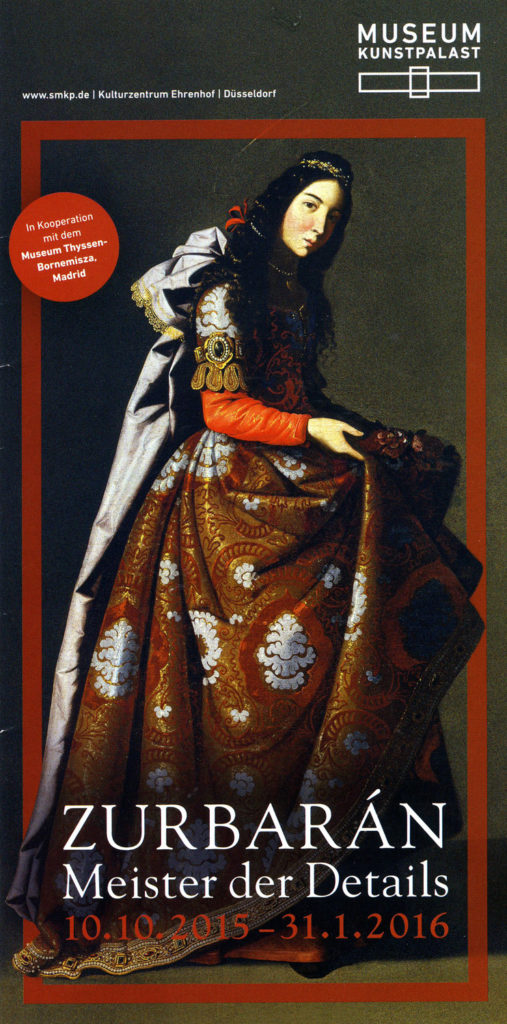
See the trailer for the exhibit here:
The stunning poster drew me in for the latest exhibit in Düsseldorf’s Museum Kunstpalast. It was called “Zurbarán: Meister der Details” [Master of Details] and features 16th-century full-size portraits by the Spanish painter Francisco de Zurbarán (1598-1664).
My first reaction to the poster was: “There she is!” She is the queen antagonist for my new middle grade work-in-progress.
The extreme contrast of ivory skin and long, black hair, the 397 pearls on the hem of her gown, and the intensity of her eyes, almost scornful–certainly assessing–give the sense that you’ve caught her attention and it may not be to your advantage.
She’s caught up her brocade gown with one, white, elegant, hand and is ready to move. She’s only paused to run her eye over you.
Only after I went into the exhibit did I realize that the tiny flaw in the canvas above her head is actually a halo. The painting’s subject is St. Casilda, not an evil queen at all.
If I borrow his St. Casilda and embroider a character for my latest middle grade adventure, I’m only following his example. The rich gown is an invention of the painter, the son of a cloth merchant, who invented the elegant fashions of his subjects based on his father’s cloth samples.
There are advantages to drawing characters from a master. The artist works in a visual medium and the character traits that are words to me, are the artist’s details of dress, expression, and gesture. The artist paints a mood with colors and light and, through his painting, I can borrow his eyes to sketch a vivid character.
If you’d like to try it yourself, here are a few suggestions:
- Cast an eye over the museum guards and visitors. Anyone who thinks there’s no romance to a museum guard hasn’t read FROM THE MIXED UP FILES OF MRS. BASIL E. FRANKWEILER (or seen Audrey Hepburn in HOW TO STEAL A MILLION). What visitors say and do in museums tells another set of stories. Sometimes I catch a moment of conscious or unconscious mimicry or hear a wonderful snippet of dialogue that helps my story along.
2. If your museum doesn’t have portraits, try a more literal use of a painting. In C.S. Lewis’s THE VOYAGE OF THE DAWN TREADER, a painting of a Narnian ship turns into a portal to the imaginary world of Narnia.
3. Prep a character or two before your museum visit. The Reverse Backstory Tool is an efficient tool for working out the connection between your character’s want, need, flaw, and wound. The “Reverse Backstory Tool” appears in Appendix B of THE NEGATIVE TRAIT THESAURUS by Angela Acker and Becca Puglisi. The tool is handy to prep before your museum visit or to develop characters who’ve caught your eye in the museum.
Art museums are a treasure trove for characters. The artists have done all the work of people-watching and the paintings already express personalities and stories. It’s all ready-to-pick, so go ahead and fill the well.
Do you find art museums inspiring? What do you enjoy about them?
